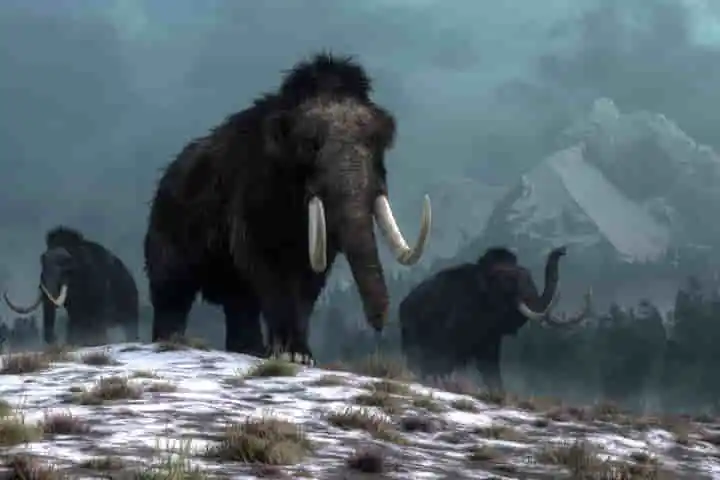

A recent study suggests that extinction of giant herbivorous creatures like the woolly mammoth trigger a spurt in the wild fires (Pic. Courtesy scitechdaily.com)
<p>
<strong>A study led by Yale, published in the journal Science this week, has highlighted a vital connection between the extinction of grassland grazers and a spurt in fire activity in those areas according to an article in scitechdaily.com.</strong></p>
<p>
Some of the earth&rsquo;s biggest animals, like the woolly mammoth, ancient horses and giant bison went extinct from 50,000 to 6,000 years ago and the loss of these species which grazed the grasslands triggered an increase in fire there.</p>
<p>
The researchers of Yale in association with the Utah Natural History Museum, listed out the large mammals spread out in four continents, who became extinct, and the estimated time of their disappearance. Figures showed that South America lost 83 per cent of all species, while North America lost 68 per cent and these figures were much more than the Australian and African figures which were 44 per cent and 22 per cent respectively.</p>
<p>
<strong>Also read: <a href="https://www.indianarrative.com/science-news/vulture-bees-of-costa-rica-feast-on-meat-131217.html">Vulture bees of Costa Rica feast on meat</a></strong></p>
<p>
Having got these figures, the team next studied the fire activity records. This was gathered by using charcoal records from 410 global sites which indicated the fire activity in the region across the continents. To their surprise, this activity rose with the exit of the mega grazers. Thus, South and North Americas which had lost a huge number of grazers witnessed larger increase in fire while those continents like Africa and Australia that had lower rate of extinction encountered very less change in fire activity in grassland.</p>
<p>
Postdoctoral associate in Department of Ecology and Evolutionary Biology at and corresponding author of the paper, Allison Karp observed: <a href="https://scitechdaily.com/extinction-of-ancient-grazers-triggered-a-global-rise-in-fires/">&ldquo;These extinctions led to a cascade of consequences.</a> Studying these effects helps us understand how herbivores shape global ecology today.&rdquo;</p>
<p>
Elimination of the mega herbivore creatures had significant ramifications on the environment. It ranged from collapse of predators to fruit-bearing trees being lost which relied on these herbivores for their dispersal.</p>
<p>
Along with the study&rsquo;s senior author Carla Staver, who is also an associate professor at Yale&rsquo;s ecology and evolutionary biology in Faculty of Arts and Sciences, Karp pondered if the spike in fire was linked to increase in leaves, dry grass and wood brought about due to giant herbivores vanishing from the scene. The two discovered that grass fuelled fires did increase in the grasslands.</p>
<p>
Along with these observations, Karp and Staver, however, noted that during the discussed period species like mastodons, diprotodons, and giant sloths &ndash; who fed on trees and shrubs of the wooded areas &mdash; also went extinct during the same period but that their losses had less impact on fires in wooded areas.</p>
<p>
<strong>Also read: <a href="https://www.indianarrative.com/science-news/pacific-bully-lingcod-loses-and-grows-teeth-everyday-to-feed-like-a-pig-128916.html">Pacific lingcod-a predatory fish with 500 teeth to feed its huge appetite</a></strong></p>
<p>
There was a transformation in the ecosystem of the grassland with the loss of grasses that were grazing tolerant following the disappearance of herbivores and surge in fires. With the new ecosystem coming up, the new grazers, including livestock, adapted.</p>
<p>
Stressing on the role and importance of livestock and wild grazers in mitigation of fire and change in climate, Staver remarked: &ldquo;This work really highlights how important grazers may be for shaping fire activity. We need to pay close attention to these interactions if we want to accurately predict the future of fires.&rdquo;</p>
The sixteenth meeting of the India-Nepal Bilateral Consultative Group on Security Issues (INBCGSI) was held…
Finance Minister Nirmala Sitharaman on Monday lauded the resilience of Indian exporters, highlighting that the…
Israel Defence Minister Israel Katz has accused Iran of violating the ceasefire and said that…
External Affairs Minister S Jaishankar held a meeting with South Australia's Governor Frances Adamson in…
Union Minister for Communications and Development of the Northeastern Region Jyotiraditya Scindia on Tuesday highlighted…
India handed over 1000 metric tonnes of rice and essential medicines to Cameroon. Cameroon's Minister…